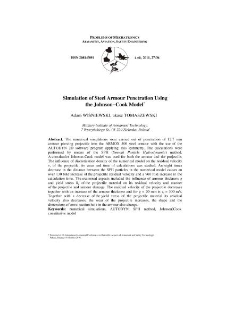Nasza Biblioteka Cyfrowa udostępnia 1 868 obiektów cyfrowych
Obiekt
Tytuł: Simulation of Steel Armour Penetration Using the Johnson-Cook Model ; Simulation of Steel Armour Penetration Using the Johnson-Cook Model
Współtwórca:
Łukasz TOMASZEWSKI ; Łukasz TOMASZEWSKI
Abstrakt:
The numerical simulations were carried out of penetration of 12.7 mm armour piercing projectile into the ARMOX 500 steel armour with the use of the AUTODYN 2D software program applying axis symmetry. The calculations were performed by means of the SPH (Smooth Particle Hydrodynamic) method. A constitutive Johnson-Cook model was used for both the armour and the projectile. The influence of discretization density of the numerical model on the residual velocity vr of the projectile, its wear and time of calculations was studied. An eight times decrease in the distance between the SPH particles in the numerical model causes an over 130 fold increase of the projectile residual velocity and a 960 fold increase in the calculation time. The examined aspects included the influence of armour thickness g and yield stress Re of the projectile material on its residual velocity and manner of the projectile and armour damage. The residual velocity of the projectile decreases together with an increase of the armour thickness and for g = 20 mm is vr = 300 m/s. Together with a decrease of the yield stress of the projectile material its residual velocity also decreases, the wear of the projectile increases, the shape and the dimensions of cross section hole in the armour also change.
;
The numerical simulations were carried out of penetration of 12.7 mm armour piercing projectile into the ARMOX 500 steel armour with the use of the AUTODYN 2D software program applying axis symmetry. The calculations were performed by means of the SPH (Smooth Particle Hydrodynamic) method. A constitutive Johnson-Cook model was used for both the armour and the projectile. The influence of discretization density of the numerical model on the residual velocity vr of the projectile, its wear and time of calculations was studied. An eight times decrease in the distance between the SPH particles in the numerical model causes an over 130 fold increase of the projectile residual velocity and a 960 fold increase in the calculation time. The examined aspects included the influence of armour thickness g and yield stress Re of the projectile material on its residual velocity and manner of the projectile and armour damage. The residual velocity of the projectile decreases together with an increase of the armour thickness and for g = 20 mm is vr = 300 m/s. Together with a decrease of the yield stress of the projectile material its residual velocity also decreases, the wear of the projectile increases, the shape and the dimensions of cross section hole in the armour also change.
Miejsce wydania:
Warszawa
;
Warszawa
Wydawca:
Wojskowa Akademia Techniczna ; Wojskowa Akademia Techniczna
Data utworzenia:
Data wydania:
Rozmiar:
Identyfikator:
oai:ribes-88.man.poznan.pl:2339
ISSN elektroniczny:
ISSN drukowany:
Język:
Właściciel praw:
Wojskowa Akademia Techniczna ; Wojskowa Akademia Techniczna
Strona początkowa:
Strona końcowa:
Tom:
Słowa kluczowe:
numerical simulations, AUTODYN, SPH method, Johnson–Cook constitutive model ; numerical simulations, AUTODYN, SPH method, Johnson–Cook constitutive model
Kolekcje, do których przypisany jest obiekt:
Data ostatniej modyfikacji:
12 sie 2025
Data dodania obiektu:
12 sie 2025
Liczba wyświetleń treści obiektu:
0
Wszystkie dostępne wersje tego obiektu:
https://ribes-88.man.poznan.pl/publication/2639
Wyświetl opis w formacie RDF:
Wyświetl opis w formacie OAI-PMH:
| Nazwa wydania | Data |
|---|---|
| Simulation of Steel Armour Penetration Using the Johnson-Cook Model | 12 sie 2025 |
Obiekty Podobne
Adam WIŚNIEWSKI Dawid PACEK
Adam WIŚNIEWSKI Paweł ŻOCHOWSKI
Adam WIŚNIEWSKI
Adam WIŚNIEWSKI Dawid PACEK
Adam WIŚNIEWSKI Paweł ŻOCHOWSKI
Adam WIŚNIEWSKI Dawid PACEK

